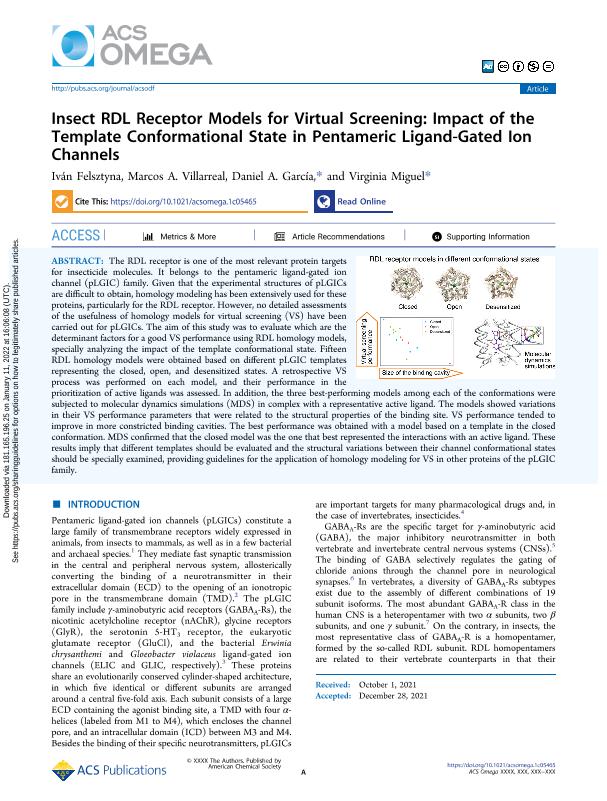Mostrar el registro sencillo del ítem
dc.contributor.author
Felsztyna, Iván

dc.contributor.author
Villarreal, Marcos Ariel

dc.contributor.author
Garcia, Daniel Asmed

dc.contributor.author
Miguel, Virginia

dc.date.available
2023-08-24T19:04:41Z
dc.date.issued
2022-01
dc.identifier.citation
Felsztyna, Iván; Villarreal, Marcos Ariel; Garcia, Daniel Asmed; Miguel, Virginia; Insect RDL Receptor Models for Virtual Screening: Impact of the Template Conformational State in Pentameric Ligand-Gated Ion Channels; American Chemical Society; ACS Omega; 7; 2; 1-2022; 1988-2001
dc.identifier.issn
2470-1343
dc.identifier.uri
http://hdl.handle.net/11336/209297
dc.description.abstract
The RDL receptor is one of the most relevant protein targets for insecticide molecules. It belongs tothe pentameric ligand-gated ion channels (pLGICs) family. Given that experimental structures ofpLGICs are difficult to obtain, homology modeling has been extensively used for these proteins,particularly for the RDL receptor. However, no detailed assessments of the usefulness of homologymodels for virtual screening (VS) have been carried out for pLGICs. The aim of this study was toevaluate which are the determinant factors for a good VS performance using RDL homologymodels, specially analyzing the impact of the template conformational state. Fifteen RDL homologymodels were obtained based on different pLGICs templates representing the closed, open anddesensitized states. A retrospective VS was performed on each model and their performance in theprioritization of active ligands was assessed. In addition, the three best-performing models amongeach of the conformations were subjected to molecular dynamics simulations (MDS) in complexwith a representative active ligand. The models showed variations in their VS performanceparameters that were related to the structural properties of the binding site. VS performance tendedto improve in more constricted binding cavities. The best performance was obtained with a modelbased on a template in the closed conformation. MDS confirmed that the closed model was the onethat best represented the interactions with an active ligand. These results imply that differenttemplates should be evaluated and the structural variations between their channel conformationalstates should be specially examined, providing guidelines for the application of homology modelingfor VS in other proteins of the pLGICs family.
dc.format
application/pdf
dc.language.iso
eng
dc.publisher
American Chemical Society

dc.rights
info:eu-repo/semantics/openAccess
dc.rights.uri
https://creativecommons.org/licenses/by-nc-nd/2.5/ar/
dc.subject
RDL RECEPTOR
dc.subject
GABAA RECEPTOR
dc.subject
INSECTICIDES
dc.subject
DOCKING
dc.subject.classification
Biofísica

dc.subject.classification
Ciencias Biológicas

dc.subject.classification
CIENCIAS NATURALES Y EXACTAS

dc.title
Insect RDL Receptor Models for Virtual Screening: Impact of the Template Conformational State in Pentameric Ligand-Gated Ion Channels
dc.type
info:eu-repo/semantics/article
dc.type
info:ar-repo/semantics/artículo
dc.type
info:eu-repo/semantics/publishedVersion
dc.date.updated
2023-07-05T15:25:28Z
dc.journal.volume
7
dc.journal.number
2
dc.journal.pagination
1988-2001
dc.journal.pais
Estados Unidos

dc.description.fil
Fil: Felsztyna, Iván. Consejo Nacional de Investigaciones Científicas y Técnicas. Centro Científico Tecnológico Conicet - Córdoba. Instituto de Investigaciones Biológicas y Tecnológicas. Universidad Nacional de Córdoba. Facultad de Ciencias Exactas, Físicas y Naturales. Instituto de Investigaciones Biológicas y Tecnológicas; Argentina
dc.description.fil
Fil: Villarreal, Marcos Ariel. Consejo Nacional de Investigaciones Científicas y Técnicas. Centro Científico Tecnológico Conicet - Córdoba. Instituto de Investigaciones en Físico-química de Córdoba. Universidad Nacional de Córdoba. Facultad de Ciencias Químicas. Instituto de Investigaciones en Físico-química de Córdoba; Argentina
dc.description.fil
Fil: Garcia, Daniel Asmed. Consejo Nacional de Investigaciones Científicas y Técnicas. Centro Científico Tecnológico Conicet - Córdoba. Instituto de Investigaciones Biológicas y Tecnológicas. Universidad Nacional de Córdoba. Facultad de Ciencias Exactas, Físicas y Naturales. Instituto de Investigaciones Biológicas y Tecnológicas; Argentina
dc.description.fil
Fil: Miguel, Virginia. Consejo Nacional de Investigaciones Científicas y Técnicas. Centro Científico Tecnológico Conicet - Córdoba. Instituto de Investigaciones Biológicas y Tecnológicas. Universidad Nacional de Córdoba. Facultad de Ciencias Exactas, Físicas y Naturales. Instituto de Investigaciones Biológicas y Tecnológicas; Argentina
dc.journal.title
ACS Omega
dc.relation.alternativeid
info:eu-repo/semantics/altIdentifier/url/https://pubs.acs.org/doi/10.1021/acsomega.1c05465
dc.relation.alternativeid
info:eu-repo/semantics/altIdentifier/doi/http://dx.doi.org/10.1021/acsomega.1c05465
Archivos asociados
